Unit 3 - Populations
3.2 K-Selected and R-Selected Species
Learning Objective
- Identify differences between k- and r-selected species
Quality vs Quantity
K-selected - “quality”
- few offspring, heavy parental care
- high reproduction rates (reproduce many times)
- ex. most mammals, birds
- long lifespan
- long time to sexual maturity = low biotic potential = slow population growth rate
- more likely to be disrupted by environmental change or invasives
R-selected - “quantity”
many offspring, little to no care
low reproduction rates (may reproduce only once)
- ex. insects, fish, plants
shorter lifespan
- quick to sexual maturity = high biotic potential = high population growth rate
- more likely to be invasive
- better suited for rapidly changing environmental conditions
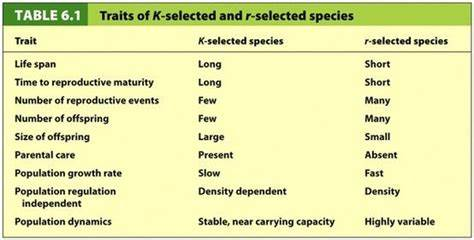
Invasiveness and Disturbances
K-selected
- low biotic potential (rep. rate) = hard for population to recover after a disturbance (env. change)
- high parental care means death of parent = death of offspring
- invasives (usually r) outcompete for resources with high biotic potential and rapid population growth
- less likely to adapt and more likely to go extinct
R-selected
- high biotic potential (rep. rate) = more rapid population recovery after disturbance
- low parental care means death of parent doesn’t impact offspring
- not as impacted by invasive species since their population grows quickly
- more likely to be invasive
- larger population and faster generation time = higher chance of adaptation and lower chance of extinction
3.3 Survivorship curves
Learning Objective
- Explain survivorship curves
Survivorship Curves
A survivorship curve is a line that shows survival rate of a cohort (group of same aged individuals) in a population from birth to death
- Faster drop in line = quicker die-off of individuals
- Slower drop in line = longer average lifespan
Type I, II, and III
Type 1 (mostly K-selected)
- high survivorship early in life due to high parental care
- high survivorship in mid life due to large size and defensive behavior
- rapid decrease in survivorship in late life as old age sets in
- ex. most mammals
Type 2 (in between r and K)
- steadily decreasing survivorship throughout life
Type 3 (mostly r-selected)
- high mortality (low survivorship) early in life due to little to no parental care
- few make it to midlife; slow, steady decline in survivorship in mid life
- even fewer make it to adulthood; slow decline in survivorship in old age
- ex. insects, fish plants
3.4 Carrying Capacity
Learning Objective
- Describe carrying capacity
- Describe the impact of carrying capacity on ecosystems
Carrying Capacity (k)
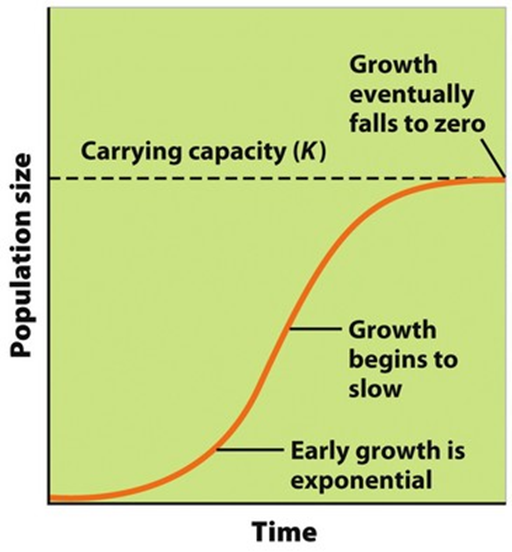
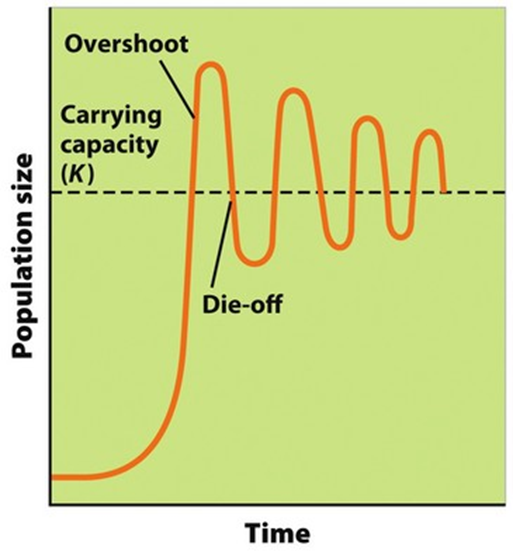
Population briefly “overshoots” (k) and then die-off happens
- the highest population size an ecosystem can support based on limiting resources:
- food
- water
- habitat (nesting sites, space)
Overshoot:
- when a population briefly exceeds carrying capacity
- ex. deer breed in fall, give birth all at once in spring; sudden spike in population = overshoot
Consequence of overshoot:
- resource depletion ex: overgrazing in deer
Die-off:
- sharp decrease in population size when resource depletion (overshoot) leads to many individuals dying
- ex. many deer starve with too many new fawns feeding in spring
Die-off Example
Reindeer of St. Paul Island
- 25 introduced in 1910
- Growth was gradual (10’ - 30’) then exponential (30’-37’)
- Carrying capacity was overshot
- Sharp die-off lead to population crash as food resource (lichen) were severely depleted
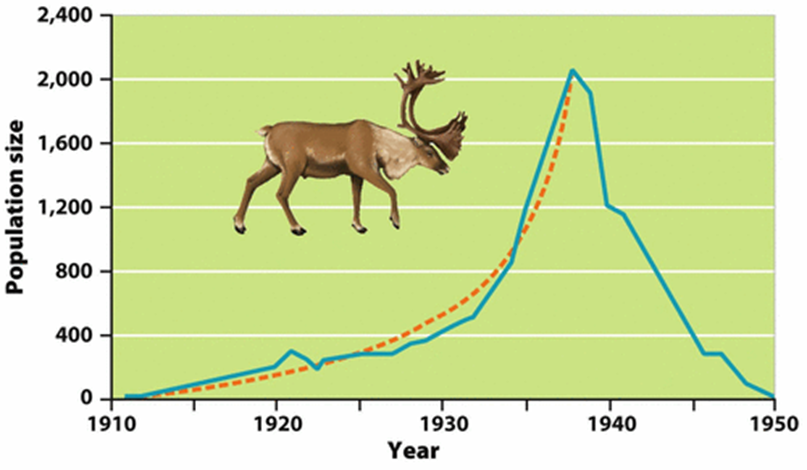
Real populations don’t always fluctuate around carrying capacity. If resource depletion is severe enough, total population crash can occur
Predator-Prey
Hare population increase due to low predator population (lynx)
Lynx population increase due to increase in food (hare)
Increasing lynx population limits hare population; leads to die-off
Hare die-off decreases lynx food source, leading to die-off
Hare population increase due to low predator population (lynx)
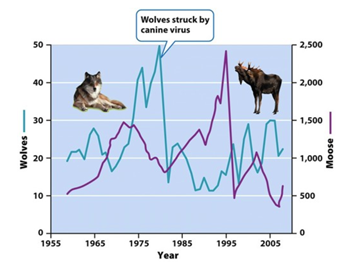 \n
\n 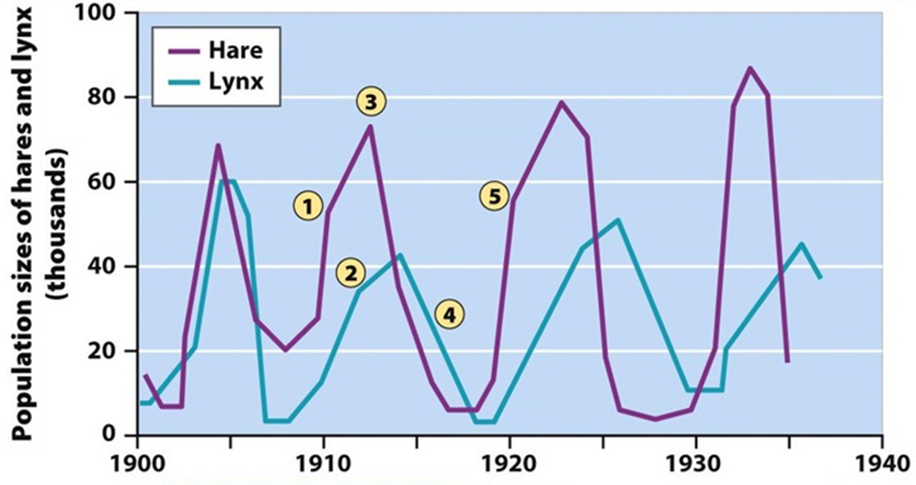
3.5 Population Growth and Resource Availability
Learning Objective
- Explain how resource availability affects population growth
Population Growth
Size (n)
- total number of individuals in a given area at a given time
- larger = safer from population decline
Density
- of individuals/area
- ex : (12 panthers/km^2)
- high density = higher competition, possibility for disease outbreak, possibility of depleting food sources
Distribution
- how individuals in population in are spaced out compared to each other
- random (trees)
- uniform (territorial animals)
- clumped (herd/group animals)
Growth Factors
Sex ratio
- ratio of males to females. the closer to 50:50, the more ideal for breeding (usually)
- die-off or bottleneck effect can lead to skewed sex ratio (not enough females) limiting population growth
Density-Dependent Factors
- factors that influence population growth based on size
- ex. food, competition for habitat, water, light, even disease
- ex. cont. when twice as much food was added, carrying capacity increased by about 2x
- all of these things limit population growth based on their size; aka - small population
Density-Independent
- factors that influence population growth independent of their size
- ex. natural disasters (flood, hurricane, tornado, fire)
- it doesn’t matter how big or small population is, natural disasters limit them both.
Biotic Potential
Biotic potential
- exponential growth
Logistic growth
- initial rapid growth, then limiting factors limit pop. to K
Biotic Potential
- max. potential growth rate, with no limiting resources
- May occur initially, but limiting resources (competition, food, disease, predators) slow growth, & eventually limit pop. to carrying capacity (k)
Calculating Population Change
Population Size = (Immigrations + births) - (immigrations + deaths)
- Ex: An elk pop. of 52 elk has 19 births and 6 deaths in a season, and 5 new \n elk immigrate to the herd and 0 elk emigrate from the heart
3.6 Age Structure Diagrams
Learning Objective
- Explain age structure diagrams
Age Cohorts
Age cohorts & growth
- groups of similarly aged individuals
0-14 = prereproductive
15 - 44 = reproductive age
45 + = post reproductive
- Size difference between 0-14 & 15-44 indicates growth rate
- Larger 0-14 cohort = current & future growth
- Roughly equal 0-14 & 15-44 = slight growth/stable
- Larger 15-44 = pop. decline
Pyramid Shapes
- Extreme Pyramid shape = rapid growth
- Less extreme pyramid = slow, stable growth
- House = stable, little to no growth
- Narrowest @ base = declining pop.
3.7 Total Fertility Rate
Learning Objective
- Explain factors that affect total fertility rate in human populations
TFR & Infant Mortality
Total Fertility Rate
- average number of children a woman in a population will bear throughout her lifetime
- higher TFR = higher birth rate, higher population growth rate (generally)
Factors that affect TFR
- development: more developed or wealthy nations have a lower TFR than less developed nations
- more educational access for women
- more economic opportunity for women
- higher access to family planning education and contraceptives
- later age of first pregnancy
- less need for children to provide income through agricultural labor
- educational and economic opportunities require more time and leave less time for raising children
- government policy can play a huge role in fertility by coercive (forceful) or non-coercive (encouraging) policies
- forced or voluntary sterilization
- china’s 1 (now 2) child policy
- tax incentives to have fewer children
- microcredits or loans to women without children to start businesses
More education = fewer unplanned pregnancies
More education = more job opportunities for women
- alternative to marrying young
Replacement Level Fertility
- the TFR required to offset deaths in a population and keep population size stable
- about 2.1 in developed countries
- higher in less developed countries due to higher infant mortality
Infant Mortality Rate (IMR)
- number of deaths of children under 1 year per 1,000 people in a population
- higher in less developed countries due to lack of access to health care, clean water, enough food, etc.
- Higher IMR = higher TFR, due to families having replacement children
- Lower IMR = Lower TMR
Factors in IMR decline
- access to clean water
- access to healthcare (hospitals, vaccines, vitamins and supplements for moms and babies)
3.8 Human Population Dynamics
Learning Objective
- Explain how human populations experience growth and decline
Does Earth Have a Human Carrying Capacity?
Malthusian theory (what Malthus theorized):
- Earth has a human carrying capacity, probably based on food production
- Human population growth is happening faster than growth of food production
- Humans will reach a carrying capacity limited by food
Technological Advancement
- Humans can alter earth’s carrying capacity with tech.
Innovation - Ex: synthetic fixation of Nitrogen in 1918 leads to
synthetic fertilizer, dramatically increasing food
supply
Birth Rate, Death Rate, and Growth
Growth Rate (r) = % increase in a population (usually per year)
- Ex: a growth rate of 5% for a population of 100 means they grow to 105
Crude Birth Rate & Crude Death Rate (CBR & CDR)
- Births & deaths per 1,000 people in a pop.
- Ex: Global CBR = 20 & CDR = 8
Calculating Growth Rate (r)
- {{Growth Rate = (CBR - CDR )/ 10{{
Rule of 70
The time it takes (in years) for a population to double is equal to 70 divided by the growth rate
Factors Affecting Human Population Growth
Factors that increase population growth
- higher TFR = higher birth rate
- high IMR can drive up TFR
- high immigration level
- increased access to clean water and healthcare (decrease death rate)
Factors that decrease population growth rate
- high death rate
- high IMR
- increased development (education and affluence)
- increased education for women
- delayed age of first child
- postponement of marriage age
Standard of Living Indicators
Standard of Living
- what the quality of life is like for people of a country based
Gross Domestic Product (GDP)
- key economic indicator of standard of living
- total value of the goods and services produced
- per capita GDP is total GDP/total population
Life Expectancy
- key health indicator of standard of living
- average age a person will live to in a given country
- increases with access to clean water, health care, and stable food sources
NOTE: High GDP and life expectancy are both indicators of developments and low population growth
3.9 Demographic Transition
Learning Objective
- Define the demographic transition
Industrialization
Industrialization
- the process of economic and social transition from an agrarian (farming) economy to an \n industrial one (manufacturing based)
Pre-industrialized/Less developed
- A country that has not yet made the \n agrarian to industrial transition
- Typically very poor (low GDP)
- Typically high death rate & high infant mortality
- High TFR for replacement children & agricultural labor
Industrializing/developing
- part way through this transition
- Decreasing death rate & IMR
- Rising GDP
Industrialized/developed
- completed the transition
- Very low DR & IMR
- Very High GDP
- Low TFR
Stage 1 - Preindustrial
- High IMR and high death rate due to lack of access to clean water, stable food supply, and healthcare
- high TFR due to lack of access to
- education for women
- contraceptives/family planning
- need for child agricultural labor
- little to no growth due to high CBR and CDR balancing each other out
- ex. virtually no country is in phase 1
Stage 2 - Industrializing/Developing
- Modernizations brings access to clean water, healthcare, stable food supply
- IMR and CDR decline
- TFR remains high due to
- lack of education for women and contraceptives/family planning
- need for child agricultural labor
- generational lag (takes time for education and societal change to spread)
- Economic and societal indicators
- low per capita GDP
- shorter life expectancy
- high infant mortality
- high TFR
- low literacy rate and school expectancy for girls
NOTE: rapid growth due to high CBR and declining CDR
Stage 3 - Developed/Industrialized
- modernized economy and society increase family income, so TFR declines significantly due to
- more education opportunities for women
- delayed age of marriage and first child to focus on education and career
- access to family planning and contraceptives
- economical and social indicators
- high per capita GDP
- long life expectancy
- low infant mortality
- TFR near replacement level
- high literacy rate and school life expectancy for all
Stage 4 - Post-industrialized/Highly Developed
- highly modernized countries that are very affluent
- TFR declines even further as families become more wealthy and spend even more time on educational and career pursuits
- increased wealth and education brings even more prevalent use of family planning and contraception
- economical and social indicators
- very high per capita GDP
- longest life expectancy
- TFR below replacement level
- highest contraceptive use rates
NOTE: CBR drops lower that CDR and growth becomes negative (population decline)